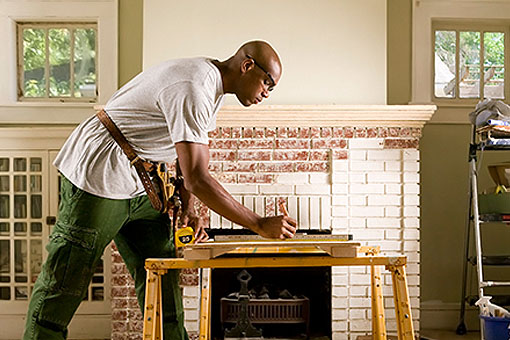How much house can I afford?
This affordability calculator shows what your monthly mortgage payment can be and is influenced by many factors, including the price of the home, your down payment, the length of the loan, property taxes, homeowners insurance and the interest rate on the loan. Enter your details below to estimate your monthly mortgage payment.
Your Results
Based on the information you entered, you could qualify for a mortgage loan up to:
| Estimated Mortgage Loan Range | |
|---|---|
| $157,000 - $282,000 | |
We're sorry. You may not qualify for a mortgage loan with us.
You entered your monthly income at $6,700.
In order to qualify for a mortgage, your monthly expenses would have to be less than $XXX,XXX.
You may qualify for another kind of loan or line of credit. Call (800) 236-3617 to speak with a banker to discuss your options or learn more about mortgages.
These estimates are provided for informational purposes only. Always consult a banker for your individual situation.
How to use this home affordability calculator
We’ve provided sample numbers so you can see how the calculator works before entering your own details.
- Monthly income: Enter your total gross monthly income before taxes and deductions. This includes wages, bonuses, commissions and any other reliable sources of income.
- Monthly expenses: Estimate your total monthly debt payments, such as car loans, student loans, credit card payments and other recurring obligations. This helps determine how much of your income is available for a mortgage payment.
- Loan term: Select the length of time you plan to repay your mortgage. For a fixed-rate mortgage these are commonly 15, 20 or 30 years. Longer terms usually lower your monthly payment but increase the total interest paid over the life of the loan.
- Interest rate: Enter the annual interest rate you expect for your mortgage. The rate affects both your monthly payment and the total amount you can afford to borrow.
- Calculate: Click to see your estimated mortgage loan range. The calculator uses your income, expenses, rate and loan term to estimate the amount you may qualify to borrow.
Tip: Adjust the interest rate and term length to compare different mortgage options, and see how changes affect your estimated affordable home loan range.
How to read your home affordability calculator results
Once you enter your income, expenses, loan term, and interest rate, the calculator estimates the mortgage loan range you may qualify for. Here’s how to interpret your results:
- Estimated mortgage loan range: The range shows the potential borrowing amount you might qualify for based on your income and expenses. The lower number represents a more conservative estimate (ideal for budgeting comfortably), while the higher number represents the maximum you may be eligible for depending on lender criteria.
- What affects the range: Debt-to-Income Ratio (DTI) is a determining factor for lenders who typically allow your total monthly debts (including your future mortgage) to stay below a certain percentage of your income: often 36% - 43%.
- Credit score: Strong credit can increase your approved amount and help you secure better interest rates.
- Loan term: A longer term (like 30 years) generally increases the maximum loan amount since monthly payments are lower.
- Interest rate: Lower rates reduce monthly payments, which can raise the amount you qualify to borrow.
Tip: Use this range as a planning guide, not a final mortgage loan offer. For the most accurate number, consult with a mortgage lender who can factor in your credit, down payment and full financial profile.
What are the next steps?
You’ve explored how much you might be able to borrow and what factors affect affordability. Now take the next step toward homeownership.
- Get prequalified: Talk to a mortgage loan officer about prequalification to see how much you can borrow based on your full financial picture, including credit, income, and savings.
- Explore loan options: Compare fixed-rate and adjustable-rate mortgages to find the one that best fits your goals and budget.
- Plan your down payment: Review savings strategies or down payment assistance programs that can help you buy sooner.
- Estimate closing costs: Use our Closing Cost Estimator to prepare for the final expenses of buying your home.
Tip: Starting the conversation early helps you understand your options, lock in competitive rates and move faster when you find the right home.
What’s not included in this estimate?
The results from this calculator provide a general idea of how much you may be able to borrow, but they don’t reflect every cost or factor lenders consider when issuing a mortgage. Keep in mind:
- Taxes and Insurance: Property taxes and homeowners insurance can significantly affect your total monthly payment and overall affordability. These are not included in this calculation.
- Down Payment: The calculator assumes only income and expenses but does not factor in how your down payment could affect the loan amount or monthly cost.
- Private Mortgage Insurance (PMI): If your down payment is less than 20%, PMI may be required, increasing your total monthly payment.
- Closing Costs: Fees such as loan origination, appraisal, and title charges are not included in the estimated loan range.
- Lender-Specific Criteria: Actual approval amounts depend on your credit score, debt-to-income ratio, assets and other financial details reviewed during underwriting.
Tip: Use this calculator as a starting point to gauge what’s affordable. For a more personalized estimate, connect with a mortgage banker who can review your full financial profile and current interest rates.
What other factors affect how much house you can afford?
Beyond your income, expenses and loan term, several key factors influence how much home you can comfortably afford:
- Debt-to-income ratio (DTI): Lenders typically prefer your total monthly debts (including your new mortgage) to stay below 43% of your gross income.
- Credit score: Higher credit scores often lead to lower interest rates, improving your borrowing power and long-term affordability.
- Interest rate trends: Even small changes in rates can impact your budget. Compare fixed vs. adjustable options to find the best fit.
- Property taxes and insurance: These ongoing costs can vary significantly by location and may affect how much you can spend on the home itself.
- Lifestyle and savings goals: Consider what portion of your income you want to keep available for travel, retirement or emergencies.
Tip: Affordability isn’t just about what you qualify for, it’s about what’s sustainable for your lifestyle and long-term goals.
How much income should go to my mortgage payment?
Financial experts often recommend following the 28/36 rule when deciding how much of your income should go toward housing and debt payments.
28% rule:
Your total monthly mortgage payment, including principal, interest, property taxes and insurance, should not exceed 28% of your gross monthly income (income before taxes and deductions).
36% rule:
Your total monthly debt payments, including your mortgage, car loans, credit cards and other obligations, should stay below 36% of your gross income.
Example:
If you earn $6,000 per month before taxes:
- 28% of $6,000 = $1,680 → ideal maximum mortgage payment.
- 36% of $6,000 = $2,160 → total recommended limit for all debts combined.
Why it matters:
Staying within these limits helps ensure you can comfortably cover housing costs, save for other goals and handle unexpected expenses. Lenders often use similar ratios when evaluating mortgage applications.
Tip: If you live in a high-cost area or have little debt, you might afford a slightly higher housing ratio. But if you carry other loans or variable income, staying under 28% can provide valuable breathing room.
How much do I need for a down payment?
Your down payment is the amount you pay upfront when buying a home, and it directly affects your loan amount, monthly payment and whether you’ll need mortgage insurance.
Typical down payment guidelines:
- 20% down: The traditional benchmark. Puts you in a strong position with lenders, helps you avoid Private Mortgage Insurance (PMI) and often secures a better interest rate.
- 3%–5% down: Many conventional loans allow lower down payments if you have good credit and stable income. You’ll likely need to pay PMI until you reach 20% equity.
- 0%–3.5% down: FHA, VA, and USDA loans offer low or no down payment options for qualifying buyers. These can help you purchase sooner but often come with extra insurance costs or funding fees.
Example:
For a $300,000 home:
- 20% down = $60,000
- 10% down = $30,000
- 5% down = $15,000
Why it matters:
A larger down payment lowers your total loan amount, reduces your monthly payment and decreases the overall interest paid across the life of the loan.
Tip: If saving for a down payment feels overwhelming, start with what’s realistic. Many buyers begin with smaller amounts, then use strategies like budgeting, automatic savings transfers or down payment assistance programs to bridge the gap.
What should I focus on if I cannot immediately afford the house I want?
If your dream home feels out of reach right now, that doesn’t mean homeownership isn’t possible. It just may take a bit of preparation and strategy. Here are the most effective ways to move closer to your goal:
- Strengthen your credit score: Your credit directly affects your mortgage rate and borrowing power. Paying bills on time, reducing credit card balances and avoiding new debt can help improve your credit score over time.
- Save for a larger down payment: Increasing your down payment reduces how much you need to borrow, lowers monthly payments and may eliminate PMI. Save for your down payment by setting up automatic transfers into a dedicated savings account to build funds steadily.
- Pay down existing debt: Lowering your overall debt improves your debt-to-income (DTI) ratio, one of the main factors lenders consider when determining loan eligibility.
- Reevaluate your budget: Review your income and expenses to find opportunities to cut back or save more aggressively. Even small monthly adjustments to your family budget can make a big difference over a year or two.
- Explore first-time homebuyer or assistance programs: Many states and lenders offer grants, low-interest loans or down payment assistance programs that can help bridge the gap for first-time homebuyers.
- Stay flexible on home criteria: Consider expanding your search area, choosing a smaller home or looking at properties that need minor updates. You can always refinance your home or move up later as your finances grow.
Tip: Think long-term. Focus on building financial stability and improving affordability rather than rushing into a purchase. When you’re ready, you’ll be in a stronger position to buy with confidence and better terms.
Related savings tools and calculators
Want to explore more ways to grow your savings? Try our Savings Calculator to plan for a future purchase or our Closing Cost Estimator to prepare for a home purchase.





